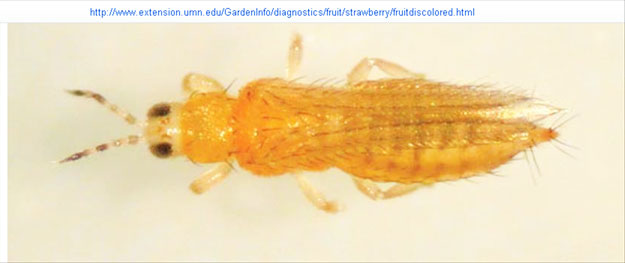Earlier this week I received an e-mail asking me a very good question. While inspecting strawberries they noticed live insects (thrips) on the strawberries. There was no feeding damage, nor was there any real evidence of damage done by the insects. Checking the US Grade Standard and USDA Inspection Instrucitons there was no mention of this being a defect of the US No. 1 Grade.
Is that right? A strawberry, or any other fruit or vegetable could have live insects crawling around on it and still make grade?

Courtesy of the Minnesota Department of Agriculture and the University of Minnesota Extension Service, these tiny insects, thrips, are virtually invisible to the naked eye. But if you take the strawberry, or any other specimen, and gently tap it over a white paper, you may be able to see these small yellow to brown specks. Using a magnifying glass you will clearly see these specks are indeed insects, some alive and moving around, and others dormant or dead.
The USDA does provide an avenue to score these specimens as damage or as serious damage defects, under the general definitions of each term. For example, the US Grade Standards for Lettuce state the head of lettuce is damage if the compact portion of the head is infested with insects or worms, and the USDA’s Inspection Instructions define just how many insects or worms constitute being infested. But this standard is the exception, as most of the other commodities have no clear definition with the number of insects allowed on a specimen, to be graded as a US No. 1.
But all the US Grade Standards do provide a general defintion of what is considered as being damaged, or a defect of the US No. 1 Grade. If the US Grade Standard does not specifically state an area allowed for a defect (ie.- 1/2 inch for bruising, or 10% of the surface for scarring) then you can default to the following guideline- “Damage” means any defect or any combination of defects, which materially detracts from the appearance, or the edible or shipping quality.
And since the presence of live insects clearly detracts from the edible quality of the commodity, the USDA will score the specimen as a defect of the US No. 1 Grade.
The number of insects allowed will vary by the commodity. This is subjective and will be left up to you, and some common sense. You would allow more insects if the commodity is going to be washed and prepped before being eaten, and you would be allowed more insects if the commodity were instance celery, lettuce, or cabbage, versus strawberries, blueberries or found in ready to eat fresh cut items.

No Comments on “Damage by other means”